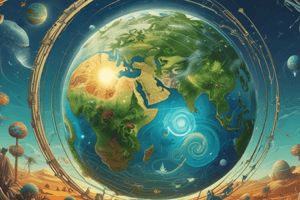Podcast
Questions and Answers
What is necessary for sustainability in ecosystems?
What is necessary for sustainability in ecosystems?
- Only energy inputs from humans
- Continuous energy input only
- A balance between energy input and output (correct)
- Reduction of all energy outputs
Who proposed the Gaia Hypothesis?
Who proposed the Gaia Hypothesis?
- James Lovelock (correct)
- David Attenborough
- Charles Darwin
- Rachel Carson
What does homeostasis refer to in the context of living organisms?
What does homeostasis refer to in the context of living organisms?
- The consumption of matter only
- The process of saving energy
- A stable internal environment (correct)
- A state of chaos and imbalance
According to the Gaia Hypothesis, how do living things on Earth interact?
According to the Gaia Hypothesis, how do living things on Earth interact?
What is emphasized by the Gaia Hypothesis regarding living things?
What is emphasized by the Gaia Hypothesis regarding living things?
What role does life play in maintaining the conditions of the biosphere?
What role does life play in maintaining the conditions of the biosphere?
What was a significant characteristic of the atmosphere in the past?
What was a significant characteristic of the atmosphere in the past?
What did bacteria contribute to the formation of sedimentary rock?
What did bacteria contribute to the formation of sedimentary rock?
What evidence indicates that O2 was released into the atmosphere over time?
What evidence indicates that O2 was released into the atmosphere over time?
Why have attempts to replicate the biosphere on a smaller scale been unsuccessful?
Why have attempts to replicate the biosphere on a smaller scale been unsuccessful?
What is the main purpose of the Haughton-Mars Project?
What is the main purpose of the Haughton-Mars Project?
Which of the following factors contribute to the formation of dead zones in oceans?
Which of the following factors contribute to the formation of dead zones in oceans?
What is one method suggested for preserving the natural balance in ecosystems?
What is one method suggested for preserving the natural balance in ecosystems?
What is a significant consequence of human interference in ecosystems?
What is a significant consequence of human interference in ecosystems?
How can nutrient runoff contribute to algal blooms?
How can nutrient runoff contribute to algal blooms?
What aspect of NASA's Advanced Life Support programs is currently being researched?
What aspect of NASA's Advanced Life Support programs is currently being researched?
What has caused the formation of approximately 150 dead zones in oceans?
What has caused the formation of approximately 150 dead zones in oceans?
What role do wind turbines play in environmental conservation efforts?
What role do wind turbines play in environmental conservation efforts?
Flashcards
Homeostasis
Homeostasis
A state of balance in the biosphere, or within an organism, where exchanges of energy and matter are balanced.
Gaia Hypothesis
Gaia Hypothesis
The idea that Earth's environment is self-regulating, and all living things work together to maintain this balance.
Energy Balance
Energy Balance
The biosphere receives energy from the Sun and releases energy as heat, and for this exchange to be sustainable it must be balanced.
Matter Exchange
Matter Exchange
Signup and view all the flashcards
Equilibrium
Equilibrium
Signup and view all the flashcards
Atmosphere Composition
Atmosphere Composition
Signup and view all the flashcards
Cellular Respiration & Photosynthesis
Cellular Respiration & Photosynthesis
Signup and view all the flashcards
Stromatolites
Stromatolites
Signup and view all the flashcards
Trapped Oxygen
Trapped Oxygen
Signup and view all the flashcards
Biosphere 2
Biosphere 2
Signup and view all the flashcards
Closed System
Closed System
Signup and view all the flashcards
Space Colony
Space Colony
Signup and view all the flashcards
Haughton-Mars Project
Haughton-Mars Project
Signup and view all the flashcards
Human Interference
Human Interference
Signup and view all the flashcards
Dead Zones
Dead Zones
Signup and view all the flashcards
Algal Bloom
Algal Bloom
Signup and view all the flashcards
Nutrient Pollution
Nutrient Pollution
Signup and view all the flashcards
Alternative Energy
Alternative Energy
Signup and view all the flashcards
Study Notes
A5 - Balance of Matter and Energy Exchange
- The biosphere constantly exchanges energy with its surroundings. It receives energy from the sun and releases radiant energy (heat).
- Sustainability happens when these energy exchanges are balanced, which is a state of homeostasis.
- Understanding the interrelationship of energy and matter is crucial to maintaining homeostasis in ecosystems, and how human activity affects this balance.
Maintaining Homeostasis
- Homeostasis is the state of balance within an organism's or an ecosystem's system.
- The Gaia Hypothesis suggests that Earth as a whole functions like a self-regulating organism maintaining homeostasis at a global scale. Developed by James Lovelock.
- All living things on Earth (the biosphere) work as a single superorganism capable of self-regulation.
Gaia Hypothesis and Living Things
- The Gaia Hypothesis is a controversial scientific idea. It emphasizes the interconnectedness of all living things.
- Each part of the biosphere must maintain a state of balance with every other component. Living things influence the systems that sustain them.
- Life on Earth significantly impacts atmospheric conditions; for example, the composition of the atmosphere would differ greatly without living organisms. Without photosynthetic lifeforms, our atmosphere would be dominated by CO2 with minimal O2.
Gaia Hypothesis and Fossil Evidence
- The early atmosphere lacked oxygen (O2). Bacteria were capable of growth in lagoons and lakes.
- Their death led to sedimentary rock build-up, sometimes called stromatolites, trapping oxygen in iron oxides.
- Later layers of stromatolites indicate that this oxygen was no longer trapped but moved from oceans to the atmosphere.
Replicating Earth's Biosphere
- Scientists have attempted to replicate the Earth's biosphere on a smaller scale (e.g., Biosphere 2).
- These attempts have not been fully successful, since Earth's biosphere is very intricate.
Future Projects
- NASA research programs (e.g., Advanced Life Support (ALS)) study ways to sustain life in space colonies.
- These projects investigate growing plants for food and oxygen generation in space. They also emphasize recycling and recovering materials.
- The Haughton-Mars Project models Martian surface conditions in the Canadian Arctic to test sustainability for future missions.
Human Interference
- Humans have a major impact on their surroundings.
- Sometimes, this changes disrupt the delicate natural balance of ecosystems.
- This disruption involves the exchange of matter and energy.
- Much effort is directed towards reducing human-generated environmental impacts.
Examples of Human Interference
- Dead zones where aquatic life suffocates.
- Nutrient-rich sediment runoff causing algal blooms, especially in coastal waters.
- Sewage, deforestation, fertilizer run-off, and livestock operations contribute to water pollution.
Preserving Natural Balance
- Developing alternative energy sources (e.g., wind turbines) is one method to reduce environmental impact.
- We need to reconsider how we use land and resources to avoid damaging ecosystems.
- The transfer of matter and energy within the biosphere is closely interrelated; water molecules that were transpired by a tree can end up in our water supply.
Studying That Suits You
Use AI to generate personalized quizzes and flashcards to suit your learning preferences.



